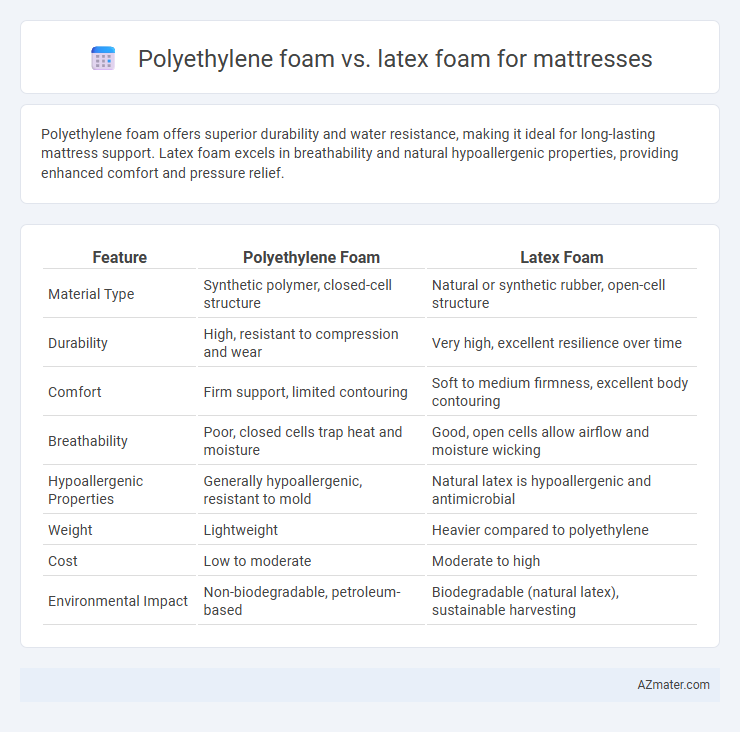Polyethylene foam offers superior durability and water resistance, making it ideal for long-lasting mattress support. Latex foam excels in breathability and natural hypoallergenic properties, providing enhanced comfort and pressure relief.
Table of Comparison
| Feature | Polyethylene Foam | Latex Foam |
|---|---|---|
| Material Type | Synthetic polymer, closed-cell structure | Natural or synthetic rubber, open-cell structure |
| Durability | High, resistant to compression and wear | Very high, excellent resilience over time |
| Comfort | Firm support, limited contouring | Soft to medium firmness, excellent body contouring |
| Breathability | Poor, closed cells trap heat and moisture | Good, open cells allow airflow and moisture wicking |
| Hypoallergenic Properties | Generally hypoallergenic, resistant to mold | Natural latex is hypoallergenic and antimicrobial |
| Weight | Lightweight | Heavier compared to polyethylene |
| Cost | Low to moderate | Moderate to high |
| Environmental Impact | Non-biodegradable, petroleum-based | Biodegradable (natural latex), sustainable harvesting |
Introduction to Polyethylene Foam and Latex Foam
Polyethylene foam is a durable, closed-cell foam known for its excellent cushioning, moisture resistance, and lightweight properties, commonly used in mattress layers for enhanced support and durability. Latex foam, derived from natural or synthetic sources, offers superior elasticity, breathability, and pressure relief, promoting comfort and hypoallergenic benefits in mattresses. Both foams serve distinct purposes: polyethylene foam excels in structural resilience, while latex foam focuses on comfort and adaptive support.
Key Material Differences
Polyethylene foam is a closed-cell, lightweight material known for its durability, water resistance, and firm support, making it ideal for mattress bases and protective layers. Latex foam, derived either naturally from rubber tree sap or synthetically, features an open-cell structure that provides superior breathability, elasticity, and pressure relief, enhancing comfort and contouring to the body. Key differences include polyethylene foam's lower breathability and higher density compared to latex foam, which offers hypoallergenic properties and greater resilience for a more responsive sleep surface.
Comfort and Support Comparison
Polyethylene foam offers firm support and good durability but tends to be less breathable and can feel stiffer compared to latex foam. Latex foam provides superior comfort with its natural elasticity, contouring closely to the body for pressure relief and enhanced support. The breathable, hypoallergenic nature of latex foam also promotes better temperature regulation, contributing to overall sleep quality.
Durability and Longevity
Polyethylene foam exhibits superior durability due to its closed-cell structure, resisting wear, compression, and moisture better than latex foam. Latex foam offers excellent resilience and natural elasticity but tends to degrade faster under prolonged heavy use, leading to reduced support over time. For longevity, polyethylene foam mattresses generally maintain their shape and firmness longer, making them ideal for users seeking extended mattress lifespan.
Breathability and Temperature Regulation
Polyethylene foam offers moderate breathability but tends to retain heat due to its closed-cell structure, making it less effective in temperature regulation compared to latex foam. Latex foam features an open-cell design that promotes superior airflow and natural moisture-wicking, enhancing breathability and maintaining a cooler sleep environment. Latex foam's ability to disperse heat efficiently makes it an optimal choice for sleepers seeking enhanced temperature control and comfort.
Allergies and Health Considerations
Polyethylene foam is hypoallergenic and resistant to dust mites, mold, and mildew, making it a suitable option for allergy sufferers. Latex foam, especially natural latex, offers antimicrobial properties and is naturally resistant to dust mites and bacteria, benefiting those with sensitive skin or respiratory issues. Both foams provide breathable and odor-free sleeping surfaces, but natural latex foam is often preferred for its eco-friendly attributes and reduced chemical exposure.
Environmental Impact and Sustainability
Polyethylene foam, derived from non-renewable petroleum resources, has a longer decomposition time and lower recyclability compared to natural latex foam, which is biodegradable and harvested from renewable rubber trees. Latex foam production emits fewer greenhouse gases and uses less energy, making it a more sustainable choice for eco-conscious consumers. Additionally, latex foam's natural antimicrobial and hypoallergenic properties reduce the need for chemical treatments, enhancing its environmental benefits over synthetic polyethylene foam.
Cost and Value Analysis
Polyethylene foam offers a lower-cost option for mattresses, providing durability and water resistance but with reduced breathability compared to latex foam. Latex foam, although more expensive, delivers superior comfort, natural antibacterial properties, and longer lifespan, justifying its higher price through enhanced value and support. Evaluating cost versus benefits, latex foam represents a premium investment for health and comfort, while polyethylene foam suits budget-conscious buyers prioritizing affordability.
Suitability for Different Sleepers
Polyethylene foam offers firm support and durability, making it ideal for back and stomach sleepers who need consistent spinal alignment. Latex foam provides excellent responsiveness and pressure relief, benefiting side sleepers by contouring to body curves and reducing pressure points. Each foam type caters to distinct sleep preferences, with polyethylene supporting stability and latex emphasizing comfort and bounce.
Final Verdict: Which Foam Is Better for Mattresses?
Polyethylene foam offers excellent durability and resistance to moisture, making it ideal for budget-friendly, supportive mattresses with longer lifespans. Latex foam provides superior pressure relief, breathability, and natural hypoallergenic properties, enhancing overall comfort and sleep quality. For those prioritizing comfort and eco-friendliness, latex foam is the better choice, while polyethylene foam suits buyers seeking affordable, washable, and dense support.

Infographic: Polyethylene foam vs Latex foam for Mattress
 azmater.com
azmater.com